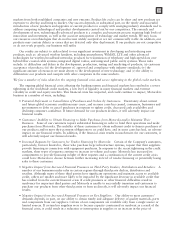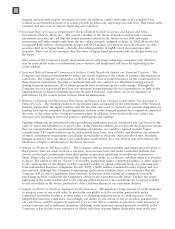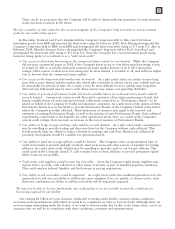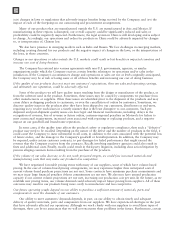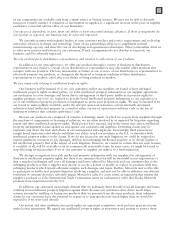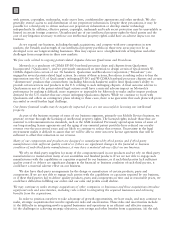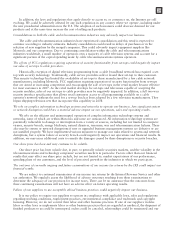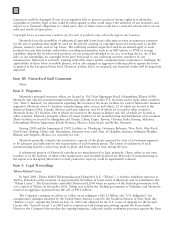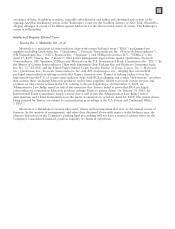Motorola 2008 Annual Report Download - page 36
Download and view the complete annual report
Please find page 36 of the 2008 Motorola annual report below. You can navigate through the pages in the report by either clicking on the pages listed below, or by using the keyword search tool below to find specific information within the annual report.
performance. Some of these laws relate to the use, disposal, clean up of, and exposure to hazardous substances. In
the United States, laws often require parties to fund remedial studies or action regardless of fault. Motorola
continues to incur disposal costs and has ongoing remediation obligations. Changes to U.S. environmental laws or
our discovery of additional obligations under these laws could have a negative impact on Motorola.
Over the last several years, laws focused on: the energy efficiency of electronic products and accessories;
recycling of both electronic products and packaging; and reducing or eliminating certain hazardous substances in
electronic products have expanded significantly. Laws pertaining to accessibility features of electronic products,
standardization of connectors and power supplies, sound levels of music playing devices, and other aspects are also
proliferating.
These laws impact our products and make it more expensive to manufacture and sell product. It may also be
difficult to comply with the laws in a timely way and we may not have compliant products available in the
quantities requested by our customers, thereby impacting our sales and profitability.
We expect these trends to continue. In addition, we anticipate increased demand to meet voluntary criteria
related to reduction or elimination of certain hazardous constituents from products, increasing energy efficiency,
and providing additional accessibility.
We are exposed to risks under large multi-year system contracts that may negatively impact our business.
We enter into large multi-year system contracts with large customers. This exposes us to risks, including:
(i) the technological risks of such contracts, especially when the contracts involve new technology, and (ii) financial
risks under these contracts, including the estimates inherent in projecting costs associated with large contracts and
the related impact on operating results. We are also facing increasing competition from traditional system
integrators and the defense industry as system contracts become larger and more complicated. Political
developments also can impact the nature and timing of these large contracts.
It is important that we are able to obtain many different types of insurance, and if we are not able to obtain
insurance we are forced to retain the risk.
The Company has many types of insurance coverage and also self-insures for some risks and obligations. The
insurance market was disrupted after the events of September 11, 2001 and the 2005 hurricanes. While the cost
and availability of most insurance has stabilized, there are still certain types and levels of insurance that remain
unavailable. Natural disasters and certain risks arising from securities claims and public liability are potential self-
insured events that could negatively impact our financial results.
Government regulation of radio frequencies may limit the growth of the wireless communications industry or
reduce barriers to entry for new competitors.
Radio frequencies are required to provide wireless services. The allocation of frequencies is regulated in the
U.S. and other countries and limited spectrum space is allocated to wireless services. The growth of the wireless
and personal communications industry may be affected: (i) by regulations relating to the access to allocated
spectrum for wireless communication users, especially in urban areas, (ii) if adequate frequencies are not allocated,
or (iii) if new technologies are not developed to better utilize the frequencies currently allocated for such use.
Industry growth has been and may continue to be affected by the cost of new licenses required to use frequencies
and any related frequency relocation costs.
The U.S. leads the world in spectrum deregulation, allowing new wireless communications technologies to be
developed and offered for sale. Examples include wireless local area network systems, such as WiFi, mesh
technologies and wide area network systems, such as WiMAX and LTE. Other countries have also deregulated
portions of their available spectrum to allow deployment of these and other technologies. Deregulation may
introduce new competition and new opportunities for Motorola and our customers.
Changes in government policies and laws or economic conditions may adversely affect our financial results.
Our results may be affected by changes in trade, monetary and fiscal policies, laws and regulations, or other
activities of U.S. and non-U.S. governments, agencies and similar organizations. Our results may also be affected
by social and economic conditions, which impact our operations, including in emerging markets in Asia, India,
Latin America and Eastern Europe, and in markets subject to ongoing political hostilities and war, including the
Middle East.
28



